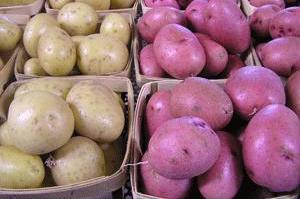Harvest is ongoing and it’s time to think about winter storage of vegetables. The key to success is harvesting at the right time, gently preparing vegetables for storage, and using the correct storage temperature and humidity.
Peppers One vegetable that seemed to thrive this year is peppers. If you have an abundance, the best way to keep hot peppers is to dry them for storage. After the fruit is mature, thread the peppers onto a string to dry. The peppers should not be touching one another or they may rot.
Hang hot peppers in a cool, dry, airy location to dry. Once dry, push them together on the string and store in a dry location between 32 and 50 degrees Fahrenheit. Dried hot peppers will keep indefinitely, but are best used within the year or they lose some of their pungent flavor.
Potatoes Late varieties of Irish potatoes store longer than early season varieties. These are best harvested after the vines die completely and when the soil is dry. Dig and handle the tubers carefully to avoid bruising. Place the tubers in a cool, dark location for 10 to 14 days to cure them; then store potatoes in a dark, 40 degrees Fahrenheit and humid location.
Winter Squash, Pumpkins and Gourds These crops are all ready to harvest when you can no longer puncture the rind with your thumbnail. These fruits must remain on the plant until they are mature or their eating and storage quality is greatly reduced. Now is a good time to pinch off smaller fruits that won’t have time to mature before frost. The plants energy can then go into maturing larger fruits.
When harvesting vine crops, avoid scratching or bruising the fruit and leave one inch of the stem attached. Mechanical wounds increase the chance of storage decay. After harvest, cure the fruit in a warm dry place for 10 days and then store them in a dry location at 55 degrees Fahrenheit.
Onions and Garlic Onions and garlic are both harvested for storage after the tops die. If the tops have not died down by late fall, harvest them before the ground freezes; taking care not to bruise the bulbs. Bruised onions and onions with thick necks should be used promptly rather than stored.
Onions must be cured, allowed to dry, until the outer skins are papery and the roots are dried to reduce storage rot. Hold them in a warm, dry location spread out on newspaper or an old screen up off the ground to dry. Once dry, the tops can be cut off and the bulbs stored in mesh bags; or, the tops can be braided together and the onions hung to store at 32 degrees Fahrenheit.
Carrots, Beets, Parsnips and Rutabagas Root crops, like carrots and beets, can be left in the garden until just before the soil freezes; or even into winter. A few good frosts will improve their flavor, as long as they are not over mature. Planting later in the season can help avoid over maturity which is when the root becomes large and woody.
When you do harvest, cut the tops to one inch above the root and dig carefully to avoid damage. Pack the roots in sawdust or other packing material and store them at 32 degrees Fahrenheit in a humid location. If you wish to leave root crops in the ground into winter, place a one foot layer of mulch over the rows to keep the soil from freezing. Pull the mulch back and dig as needed.
Because of disease problems, sanitation is an important practice to follow. After harvest of a crop is complete, dig up and discard the plants or till them under to reduce the amount of fungal spores that overwinter.

